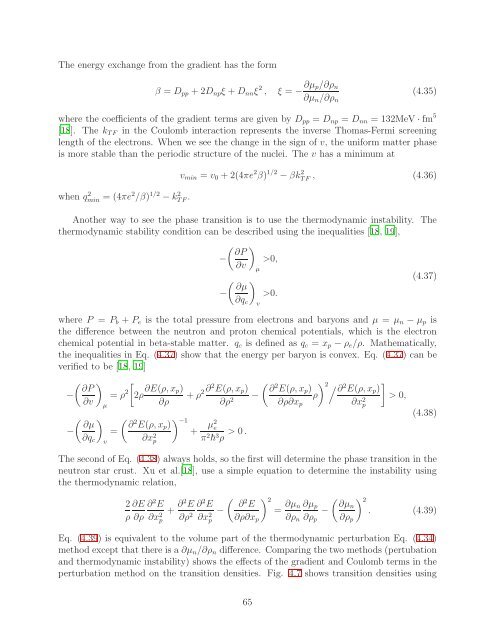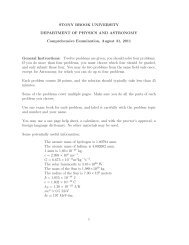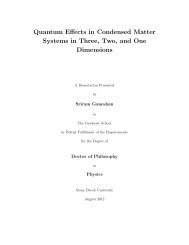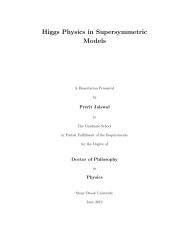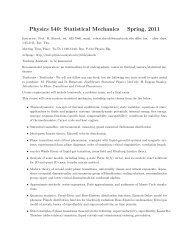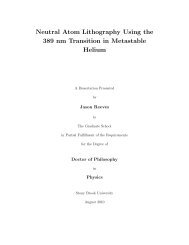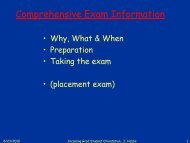Since we assume that the momentum interaction isblind with respect to isospin, the effectivemass is identical <strong>for</strong> different isospin nucleons. The effective mass to pure mass ratio <strong>of</strong>nucleons is 0.78 at the center <strong>of</strong> the heavy nuclei <strong>and</strong> becomes 1 at the outer region <strong>of</strong> theWigner-Seitz cells since the density <strong>of</strong> nuclear matter is low at the outside <strong>of</strong> the heavynuclei, the interaction energy <strong>of</strong> nuclear matter is weak.4.4 Phase transitionIn the neutron star, we can see two types <strong>of</strong> phase transitions: one is the phase transitionfrom nuclei with a neutron gas to uni<strong>for</strong>m matter, <strong>and</strong> the other is the phase transitionfrom uni<strong>for</strong>m nuclear matter to quark matter. During the first phase transition, we can seethe nuclear pasta phase [41] † . That is, spherical nuclei become ellipsoidal, then cylindrical,<strong>and</strong> finally slab phase be<strong>for</strong>e nuclear matter becomes uni<strong>for</strong>m matter. However, the energydifference is quite small, so that the effects on the large scale physics are negligible. On theother h<strong>and</strong>, the second phase transition is quite dramatic. The energy <strong>and</strong> pressure changesignificantly from nuclear matter to quark matter.4.4.1 Uni<strong>for</strong>m matterTo check the phase transition points fromheavy nuclei with a neutron gas to uni<strong>for</strong>m nuclearmatter, we can simply compare the energy per baryon <strong>of</strong> uni<strong>for</strong>m nuclear matter with theenergy per baryon <strong>of</strong> nuclei with a neutron gas since the nuclear matter exists in the lowestenergy states. The energy per baryon in uni<strong>for</strong>m matter can be easily obtained by changingthe ‘〈...〉’ integrals to non integral <strong>for</strong>m from Eq. (4.11) since the Gaussian integrations inuni<strong>for</strong>m matter become unity. Typically there is a phase transition around 0.5ρ 0 .We know that in the outer crust <strong>of</strong> the neutron star the nuclei have a BCC structure.If we assume that the pasta phase exists in the low-density region, we may use the densityperturbation to see the phase transition from nuclei with a neutron gas to uni<strong>for</strong>m nuclearmatter. We use the wave number perturbation to see the energy exchange, which has contributionsfrom the volume effects, gradient effects, <strong>and</strong> Coulomb energy can be approximated[20],v(q) ≃ v 0 +βq 2 + 4πe2 , (4.33)q 2 +kTF2where q is the sinusoidal variation <strong>of</strong> the wave number in the spatially periodic densityperturbation. The volume term is given byv 0 = ∂µ p∂ρ p− (∂µ p/∂ρ n ) 2(∂µ n /∂ρ n ) . (4.34)† Around 1/2ρ 0 , spherical nuclei is de<strong>for</strong>med to be oblate nuclei, cylindrical phase, slab, cylindrical hole,<strong>and</strong> bubble phase to minimize the total free energy density. Since its shape resembles Italian pasta, it iscalled ‘nuclear pasta’ phase.64
The energy exchange from the gradient has the <strong>for</strong>mβ = D pp +2D np ξ +D nn ξ 2 , ξ = − ∂µ p/∂ρ n∂µ n /∂ρ n(4.35)where the coefficients <strong>of</strong> the gradient terms are given by D pp = D np = D nn = 132MeV·fm 5[18]. The k TF in the Coulomb interaction represents the inverse Thomas-Fermi screeninglength <strong>of</strong> the electrons. When we see the change in the sign <strong>of</strong> v, the uni<strong>for</strong>m matter phaseis more stable than the periodic structure <strong>of</strong> the nuclei. The v has a minimum atwhen q 2 min = (4πe2 /β) 1/2 −k 2 TF .v min = v 0 +2(4πe 2 β) 1/2 −βk 2 TF , (4.36)Another way to see the phase transition is to use the thermodynamic instability. Thethermodynamic stability condition can be described using the inequalities [18, 19],( ) ∂P− >0,∂vµ( (4.37)∂µ− >0.∂q c)vwhere P = P b + P e is the total pressure from electrons <strong>and</strong> baryons <strong>and</strong> µ = µ n − µ p isthe difference between the neutron <strong>and</strong> proton chemical potentials, which is the electronchemical potential in beta-stable matter. q c is defined as q c = x p −ρ e /ρ. Mathematically,the inequalities in Eq. (4.37) show that the energy per baryon is convex. Eq. (4.37) can beverified to be [18, 19]( ) [ ∂P− = ρ 2 2ρ ∂E(ρ,x (p)+ρ 2∂2 E(ρ,x p ) ∂ 2 E(ρ,x p )− ρ∂vµ∂ρ ∂ρ 2 ∂ρ∂x p( ∂µ− =∂q c)v( ∂ 2 E(ρ,x p )∂x 2 p) 2/ ] ∂ 2 E(ρ,x p )> 0,∂x 2 p) −1+ µ2 eπ 2 3 ρ > 0. (4.38)The second <strong>of</strong> Eq. (4.38) always holds, so the first will determine the phase transition in theneutron star crust. Xu et al.[18], use a simple equation to determine the instability usingthe thermodynamic relation,2∂E∂ 2 Eρ ∂ρ ∂x 2 p+ ∂2 E∂ρ 2 ∂ 2 E∂x 2 p−( ) ∂ 2 2E= ∂µ ( ) 2n ∂µ p ∂µn− . (4.39)∂ρ∂x p ∂ρ n ∂ρ p ∂ρ pEq. (4.39) is equivalent to the volume part <strong>of</strong> the thermodynamic perturbation Eq. (4.34)method except that there is a ∂µ n /∂ρ n difference. Comparing the two methods (pertubation<strong>and</strong> thermodynamic instability) shows the effects <strong>of</strong> the gradient <strong>and</strong> Coulomb terms in theperturbation method on the transition densities. Fig. 4.7 shows transition densities using65
- Page 1 and 2:
Theory of nuclear matter of neutron
- Page 3 and 4:
Abstract of the DissertationTheory
- Page 5 and 6:
To Jaenyeong, Jonghyun, and Jongbum
- Page 7 and 8:
3.3 Optimized Parameter Set . . . .
- Page 9 and 10:
List of Figures1.1 Mass and radius
- Page 11 and 12:
SymbolsNuclear Physics SymbolE ener
- Page 13 and 14:
ω δt 90−10QtT cTaylor expansion
- Page 15 and 16:
List of Tables1.1 Range of Tables .
- Page 17 and 18:
Chapter 1IntroductionStars give us
- Page 19 and 20:
Since the mass of neutron star is d
- Page 21 and 22:
shown in Fig. 1.2, LS220 is the onl
- Page 23 and 24:
density:p = ρ2ρ o[ K9µ n = −B
- Page 25 and 26:
nuclear energy density functional i
- Page 27 and 28:
2.3.2 Thermodynamic QuantitiesThe t
- Page 29 and 30: point r and with momentum p isU n (
- Page 31 and 32: Thus, in the case of zero temperatu
- Page 33 and 34: For standard nuclear matter, u = 1
- Page 35 and 36: a α L α U β L β U σ0.5882 1.11
- Page 37 and 38: Figure 2.2: Bulk equilibrium of T =
- Page 39 and 40: Figure 2.4: Coexistence curves for
- Page 41 and 42: proton fraction x are irrelevant fo
- Page 43 and 44: potential model analogue for the Ha
- Page 45 and 46: with the convention that z II is th
- Page 47 and 48: Figure 2.10: The surface tension of
- Page 49 and 50: Figure 2.12: Contour plots of surfa
- Page 51 and 52: 2.6.2 Dense Matter and the Wigner-S
- Page 53 and 54: Figure 2.15: Proton number per unit
- Page 55 and 56: Chapter 3Modified model† The trun
- Page 57 and 58: We choose the value ǫ = 1/3. One m
- Page 59 and 60: where∆V t = T oρ o[( ρρ o) ǫ[
- Page 61 and 62: Q 1 to a small number also results
- Page 63 and 64: where p = (S v ,L) and M ij = 1 ∂
- Page 65 and 66: 3.4 Nuclear Surface TensionCompared
- Page 67 and 68: 1.41.2FRTF II ω 0 , T=0 MeVFRTF II
- Page 69 and 70: For the finite-range term, we use a
- Page 71 and 72: Landau’s quasi-particle formula g
- Page 73 and 74: The symmetry energy in nuclear matt
- Page 75 and 76: Figure 4.2: The left figure shows t
- Page 77 and 78: Figure 4.4: This figure shows the b
- Page 79: Figure 4.5: In a neutron star, heav
- Page 83 and 84: Figure 4.8: The left panel shows th
- Page 85 and 86: 4.5 Astrophysical application4.5.1
- Page 87 and 88: 0.550.5GaussianFRTF IIFRTF I0.450.4
- Page 89 and 90: neutron matter respectively. Those
- Page 91 and 92: Table 5.3: Nuclear properties of si
- Page 93 and 94: which aref Rc = a 0 +a 1 x+a 2 x 2
- Page 95 and 96: parametrized[ht]504540EDF, Z nucFit
- Page 97 and 98: Chapter 6Nuclear Equation of State
- Page 99 and 100: Coulomb, and, symmetry part [24], i
- Page 101 and 102: We can eliminate N s , leading to t
- Page 103 and 104: pressure from pure neutron matter,
- Page 105 and 106: 2.52GSRsSGISIVSkaSkI1SkI2SkI3SkI5St
- Page 107 and 108: HNsn, p, α,eFigure 6.7: In the Wig
- Page 109 and 110: Table 6.1: Surface tension analytic
- Page 111 and 112: free energy density for the alpha p
- Page 113 and 114: Here s ′ = ∂s(u)/∂u.The minim
- Page 115 and 116: 6.5.2 Determination of Coulomb surf
- Page 117 and 118: gives analytic derivatives of therm
- Page 119 and 120: 200180160Atomic number, Y p =0.45,
- Page 121 and 122: for Fermi integral. This fitting fu
- Page 123 and 124: A.1 Taylor expansion integrationThe
- Page 125 and 126: thenwhere0u − i+1 = fu− i +J
- Page 127 and 128: We separate the two integrals as in
- Page 129 and 130: Each w i can be obtained[ae −∆/
- Page 131 and 132:
By expanding e r 0/a −e −r 0/a
- Page 133 and 134:
M 3 2a 0.433 1p 0 (e 2 /a) √ π/3
- Page 135 and 136:
of find exact polynomial expression
- Page 137 and 138:
Appendix CPhase coexistenceBulk equ
- Page 139 and 140:
To summarize, we need to solve 5 eq
- Page 141 and 142:
D.1 Non-uniform electron density ap
- Page 143 and 144:
Appendix ENuclear Quantities in Non
- Page 145 and 146:
Table E.1: Non-relativistic Skyrme
- Page 147 and 148:
[20] C.J. Pethick and D.G. Ravenhal


